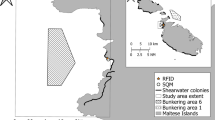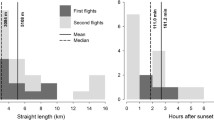Abstract
Petrels are among the most threatened group of birds. On top of facing predation by introduced mammals and incidental bycatch, these seabirds have to deal with an emerging threat, light pollution, which is increasing globally. Fledglings are disoriented and attracted to artificial lights in their maiden night flights from their nests to the sea. Once grounded, they are exposed to multiple threats leading to high mortality. We report on numbers of three petrel species (Balearic shearwater Puffinus mauretanicus, Scopoli’s shearwater Calonectris diomedea, and European storm-petrel Hydrobates pelagicus) rescued on the Balearic Islands, Mediterranean Sea, in the period 1999–2013. We assessed the proportion of grounded fledglings in the population and colonies impact based on radiance levels measured from a nocturnal satellite image. We also calculated the radius of light pollution impact. At least 304 fledgling birds were found stranded due to attraction to artificial lights, fatally affecting 8.5 % of them. The proportion of grounded fledglings ranged between 0.13 and 0.56 % of the fledglings produced annually. The body mass of Balearic and Scopoli’s shearwater fledglings decreased with rescue date. Light-induced mortality increased during the fledging period for Scopoli’s shearwaters. Birds were rescued at a mean distance of 4833 m from the nearest colony, and between 30 and 47 % of colonies were exposed to light-polluted areas. Although impact seems to be low for all species, urban development and, consequently, the increase in light pollution in the proximity of the colonies should be taken into account to reduce as much as possible this emerging source of mortality.
Zusammenfassung
Künstliches Licht und Seevögel: Stellt Lichtverschmutzung eine Bedrohung für gefährdete Sturmvögel auf den Balearen dar?Sturmvögel gehören zu den am stärksten gefährdeten Vogelgruppen. Diese Seevögel sind nicht nur der Prädation durch eingeführte Säugetiere ausgesetzt und verenden in Fischereinetzen als unbeabsichtigter Beifang, sondern sie müssen nun auch noch mit einer weiteren Bedrohung fertig werden, die weltweit zunimmt – Lichtverschmutzung. Auf ihren nächtlichen Jungfernflügen vom Nest zur See sind die Flügglinge desorientiert und werden von künstlichem Licht angezogen. Sobald sie zu Boden gegangen sind, sind sie vielfachen Gefahren ausgesetzt, die zu hoher Mortalität führen. Wir berichten, wie viele Individuen dreier Sturmvogelarten (Balearensturmtaucher Puffinus mauretanicus, Sepiasturmtaucher Calonectris diomedea und Sturmschwalbe Hydrobates pelagicus) auf den Balearischen Inseln im Mittelmeer von 1999 bis 2013 gerettet wurden. Wir haben den Anteil der zu Boden gegangenen Flügglinge in der Population und die Folgen der Helligkeit in den Kolonien (basierend auf einem nächtlichen Satellitenbild) abgeschätzt. Außerdem haben wir den Radius der Lichtverschmutzung berechnet. Mindestens 304 Flügglinge wurden gefunden, die von künstlichem Licht angezogen gestrandet waren; 8,5 % davon tot. Der Anteil zu Boden gegangener Flügglinge lag zwischen 0,13 und 0,56 % der jährlich produzierten Flügglinge. Die Köpermasse der Flügglinge von Balearen- und Sepiasturmtaucher war umso niedriger, je später diese gerettet wurden. Lichtinduzierte Mortalität nahm für Sepiasturmtaucher während der Ausfliegephase zu. Die Vögel wurden in einer mittleren Entfernung von 4833 m zur nächsten Kolonie gerettet, und 30 bis 47 % der Kolonien waren Lichtverschmutzung ausgesetzt. Obwohl die Auswirkungen für alle Arten gering zu sein scheinen, sollte die urbane Entwicklung und folglich die Zunahme der Lichtverschmutzung in der Nähe der Kolonien so erfolgen, dass diese aufkommende Todesursache so weit wie möglich reduziert wird.



Similar content being viewed by others
References
Ainley DG, Podolsky R, Nur N, Deforest L, Spencer GA (2001) Status and population trends of the Newell’s Shearwater on Kauai: insights from modelling. Stud Avian Biol 22:108–123
Amengual JF, Aguilar JS (1998) The impact of the black rat (Rattus rattus) on the reproduction of Cory’s shearwater Calonectris diomedea in the Cabrera National Park, Balearic Islands, Spain. In: Walmsley JG, Goutner V, El Hili A, Sultana J (eds) Ecologie des oiseaux marins et gestion intégrée du littoral en Méditerranée. 4éme symposium méditerranéen des oiseaux marins, Hammamet, 11–16 April 1995. Arc Editions, Rades, pp 94–121
Arcos JM (2011) International species action plan for the Balearic shearwater, Puffinus mauretanicus. SEO/BirdLife & BirdLife International
Baccetti N, Sposimo P, Giannini F (2005) Artificial lights and mortality of Cory’s shearwater Calonectris diomedea on a Mediterranean island. Avocetta 29:89–91
BirdLife International (2015) IUCN Red List for birds. http://www.birdlife.org. Accessed 27 Mar 2015
Croxall JP, Butchart SHM, Lascelles B, Stattersfield AJ, Sullivan B et al (2012) Seabird conservation status, threats and priority actions: a global assessment. Bird Conserv Int 22:1–34
Day RH, Cooper BA, Telfer TC (2003) Decline of Townsend’s (Newell’s) shearwaters (Puffinus auricularis newelli) on Kauai, Hawaii. Auk 120:669–679
de Miguel AS, Zamorano J, Gómez Castaño J, Pascual S (2014) Evolution of the energy consumed by street lighting in Spain estimated with DMSP-OLS data. J Quant Spectrosc Radiat Transf 139:109–117
Elvidge CD, Baugh K, Zhizhin M, Hsu FC (2013) Why VIIRS data are superior to DMSP for mapping nighttime lights. Proc Asia-Pac Adv Netw 35:62–69
Fontaine R, Gimenez O, Bried J (2011) The impact of introduced predators, light-induced mortality of fledglings and poaching on the dynamics of the Cory’s shearwater (Calonectris diomedea) population from the Azores, northeastern subtropical Atlantic. Biol Conserv 144:1998–2011
García D (2009) Predation on the endemic Balearic Shearwater Puffinus mauretanicus by Peregrine Falcon Falco peregrinus. Alauda 77:230–231
Gaston KJ, Duffy JP, Gaston S, Bennie J, Davies TW (2014) Human alteration of natural light cycles: causes and ecological consequences. Oecologia 176:917–931
Genovart M, Juste J, Contreras-Díaz H, Oro D (2012) Genetic and phenotypic differentiation between the critically endangered Balearic shearwater and neighboring colonies of its sibling species. J Hered 103:330–341
Glass JP, Ryan PG (2013) Reduced seabird night strikes and mortality in the Tristan rock lobster fishery. Afr J Mar Sci 35:589–592
Griesemer AM, Holmes ND (2011) Newell’s shearwater population modeling for habitat conservation plan and recovery planning. Technical Report 176. The Hawaii Pacific Island Cooperative Ecosystem Studies Unit and Pacific Cooperative Studies Unit, Honolulu, HI, USA
Hölker F, Moss T, Griefahn B, Kloas W, Voigt CC et al (2010a) The dark side of light: a transdisciplinary research agenda for light pollution policy. Ecol Soc 15:13
Hölker F, Wolter C, Perkin EK, Tockner K (2010b) Light pollution as a biodiversity threat. Trends Ecol Evol 25:681–682
IBESTAT (2014) Institut d’Estadística de les Illes Balears. Conselleria d’Economia I Competitivitat, Govern de les Illes Balears. http://ibestat.caib.es/ibestat/inici. Accessed 26 Aug 2014
Laguna JM, Barbara N, Metzger B (2014) Light pollution impact on “tubenose” seabirds: an overview of areas of concern in the Maltese Islands. BirdLife Malta. http://www.birdlifemalta.org/photos/otherfiles/5922.pdf. Accessed 1 Dec 2014
Le Corre M, Ollivier A, Ribes S, Jouventin P (2002) Light-induced mortality of petrels: a 4-year study from Réunion Island (Indian Ocean). Biol Conserv 105:93–102
Longcore T, Rich C (2004) Ecological light pollution. Front Ecol Environ 2:191–198
Madroño A, González C, Atienza JC (2004) Libro rojo de las aves de España. Dirección General para la Conservación de la Biodiversidad-SEO/BirdLife, Madrid, Spain
Merkel FR, Johansen KL (2011) Light-induced bird strikes on vessels in Southwest Greenland. Mar Pollut Bull 62:2330–2336
Miles W, Money S, Luxmoore R, Furness RW (2010) Effects of artificial lights and moonlight on petrels at St Kilda. Bird Study 57:244–251
Miles WTS, Parsons M, Close AJ, Luxmoore R, Furness RW (2013) Predator-avoidance behaviour in a nocturnal petrel exposed to a novel predator. Ibis 155:16–31
Mougin J-L, Jouanin C, Roux F, Zino F (2000) Fledging weight and juvenile survival of Cory’s shearwater Calonectris diomedea on Selvagem Grande. Ring Migr 20:107–110
Oro D, Aguilar JS, Igual JM, Louzao M (2004) Modelling demography and extinction risk in the endangered Balearic shearwater. Biol Conserv 116:93–102
Oro D, De León A, Minguez E, Furness RW (2005) Estimating predation on breeding European storm-petrels (Hydrobates pelagicus) by yellow-legged gulls (Larus michahellis). J Zool Lond 265:421–429
Podolsky R, Ainley D, Spencer G, Deforest L, Nur N (1998) Mortality of Newell’s shearwaters caused by collisions with urban structures on Kauai. Colon Waterbirds 21:20–34
Raine H, Borg JJ, Raine A, Bariner S, Cardona MB (2007) Light pollution and its effect on Yelkouan shearwaters in Malta; causes and solutions. Malta: Life Project Yelkouan Shearwater. BirdLife Malta. http://www.birdlifemalta.org/photos/otherfiles/370.pdf. Accessed 1 Aug 2014
Reed JR, Sincock JL, Hailman JP (1985) Light attraction in endangered procellariiform birds: reduction by shielding upward radiation. Auk 102:377–383
Rich C, Longcore T (eds) (2006) Ecological consequences of artificial night lighting. Island Press, Washington, USA
Rodrigues P, Aubrecht C, Gil A, Longcore T, Elvidge C (2012) Remote sensing to map influence of light pollution on Cory’s shearwater in São Miguel Island, Azores Archipelago. Eur J Wildl Res 58:147–155
Rodríguez A, Rodríguez B (2009) Attraction of petrels to artificial lights in the Canary Islands: effect of the moon phase and age class. Ibis 151:299–310
Rodríguez A, Rodríguez B, Curbelo A, Pérez A, Marrero S, Negro JJ (2012a) Factors affecting mortality of shearwaters stranded by light pollution. Anim Conserv 15:519–526
Rodríguez A, Rodríguez B, Lucas MP (2012b) Trends in numbers of petrels attracted to artificial lights suggest population declines in Tenerife, Canary Islands. Ibis 154:167–172
Rodríguez A, Burgan G, Dann P, Jessop R, Negro JJ, Chiaradia A (2014) Fatal attraction of short-tailed shearwaters to artificial lights. PLoS ONE 9:e110114
Rodríguez A, Rodríguez B, Negro JJ (2015) GPS tracking for mapping seabird mortality induced by light pollution. Sci Rep 5:10670
Ronconi RA, Allard KA, Taylor PD (2014) Bird interactions with offshore oil and gas platforms: review of impacts and monitoring techniques. J Environ Manag 147:34–45
Sanz-Aguilar A, Tavecchia G, Pradel R, Minguez E, Oro D (2008) The cost of reproduction and experience-dependent vital rates in a small petrel. Ecology 89:3195–3203
Sanz-Aguilar A, Tavecchia G, Genovart M, Igual JM, Oro D (2011) Studying the reproductive skipping behavior in long-lived birds by adding nest inspection to individual-based data. Ecol Appl 21:555–564
Sauleda CV (2006) Libro Rojo de los vertebrados de las Baleares, 3rd edn. Conselleria de Medi Ambient, Govern de les Illes Balears
Tavecchia G, Minguez E, de León A, Louzao M, Oro D (2008) Living close, doing differently: small-scale asynchrony. Ecology 89:77–85
Telfer TC, Sincock JL, Byrd GV, Reed JR (1987) Attraction of Hawaiian seabirds to lights: conservation efforts and effects of moon phase. Wildl Soc Bull 15:406–413
Troy JR, Holmes ND, Green MC (2011) Modeling artificial light viewed by fledgling seabirds. Ecosphere 2:109
Troy JR, Holmes ND, Veech JA, Green MC (2013) Using observed seabird fallout records to infer patterns of attraction to artificial light. Endanger Species Res 22:225–234
Wiese FK, Montevecchi WA, Davoren GK, Huettmann F, Diamond AW, Linke J (2001) Seabirds at risk around offshore oil platforms in the north-west Atlantic. Mar Pollut Bull 42:1285–1290
Wynn RB, Rodríguez-Molina A, McMinn-Grivé M (2010) The predation of Balearic shearwaters by peregrine falcons. Br Birds 103:350–356
Acknowledgments
We are deeply thankful to all the anonymous people who kindly helped rescue the birds, to Manolo Suárez and Raül Escandell for providing ringing data of fledglings at colonies, and to Cristòfol Mascaró and Nieves Negre for their help in the fieldwork and information gathering. We are also indebted to the personnel of the wildlife rehabilitation centres for their help and collaboration. Ana Sanz-Aguilar, Andie Filadoro and two anonymous reviewers provided interesting comments on earlier drafts. The support given by the species protection service of the counselling environment of the Balearic Islands’ Government and by a Marie Curie International Outgoing Fellowship within the 7th European Community Framework Programme (No. 330655 FP7-PEOPLE-2012-IOF) was crucial to conduct this research.
Author information
Authors and Affiliations
Corresponding author
Additional information
Communicated by C. Barbraud.
Rights and permissions
About this article
Cite this article
Rodríguez, A., García, D., Rodríguez, B. et al. Artificial lights and seabirds: is light pollution a threat for the threatened Balearic petrels?. J Ornithol 156, 893–902 (2015). https://doi.org/10.1007/s10336-015-1232-3
Received:
Revised:
Accepted:
Published:
Issue Date:
DOI: https://doi.org/10.1007/s10336-015-1232-3




